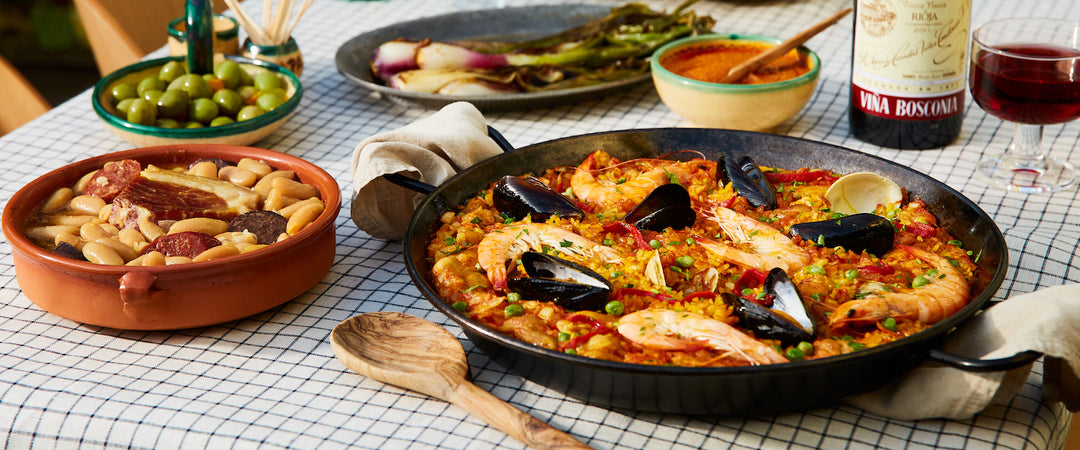October 2025 Tinto Club
 
|
Vinedos de Norrel Robertson Regular Price: $46.99
Club Price: $39.94
|
If Charlotte Allen’s La Píríta (our April 2025 ByT red) told the story of an Englishwoman mastering the native grapes of Arribes (Juan García, Rufete, and Bruñal) then Norrel Robertson’s “Manda Huevos” is its spiritual cousin from Aragón. Like Charlotte, Norrel is an expat who chose Spain, learned its soils, and earned the respect of its winemakers not by imitation but by immersion. A Master of Wine from Scotland, Norrel moved to Calatayud in 2003, drawn by the haunting beauty of its crumbling villages and its ancient Garnacha vines clinging to rocky hillsides. The Spanish call him El Escocés Volante—“The Flying Scotsman”—a nickname that sticks because his career has spanned continents, yet his wines are firmly rooted in place.
Norrel’s work revolves around single vineyards, each a self-contained world of exposure, soil, and vine age. “Manda Huevos” comes from Caña Andrea, two adjoining parcels near Villarroya de la Sierra, one planted in 1908, the other in 1970, and both at elevations around 750 meters. The older plot is a true field blend, where Garnacha grows side by side with Moristel, Bobal, and even Garnacha Blanca, a mix that adds depth and subtle aromatic lift to the wine’s red fruit core. The soils are red clay and limestone studded with pudding stones, a landscape that forces vines to struggle, yielding small clusters of concentrated berries with remarkable balance between ripeness and acidity.
For the 2019 vintage, Norrel embraced a light hand in the cellar: 20% whole clusters, spontaneous fermentation in open-top vats, and aging primarily in Flextank eggs, which maintain purity of fruit without imparting oak flavor. A single neutral 500-liter barrel rounded out the blend, and only 3,731 bottles were produced. The result is a wine of paradox: ripe yet restrained, structured yet ethereal, carrying that signature mountain freshness that defines the best high-altitude Garnacha. It’s a wine that mirrors Norrel’s intellectual precision and his belief that restraint is the truest path to expression.
Norrel’s reputation today extends far beyond this label. Some of his top single-vineyard bottlings fetch prices north of $100, revered by collectors for their finesse and longevity. Yet “Manda Huevos,” with its sly name (anyone wanna guess?) and humble origins, captures the beating heart of his philosophy: wines of character, made from places that deserve to be known by name. Each vineyard, he says, is a story waiting to be told—and this one speaks of red dust, century-old roots, and a foreigner who made Aragón his home.
Like Charlotte’s wines from Arribes, “Manda Huevos” reminds us that Spain’s most exciting winemaking often comes from outsiders who’ve learned to listen deeply to the land. It’s Garnacha reimagined—not the heavy, jammy stereotype, but a perfumed, lifted, chalky expression that feels closer to fine Pinot Noir than to rustic country red. In the glass, it’s a dialogue between old vines and new eyes—a Scotsman’s reverent love letter to Spanish soil. And in a sky of native born superstars with names like Raul Perez and Alvaro Palacios, it's nice to see an immigrant star shine.
It's a wine that I feel needs a moment of focus. Enjoy it's blend of austerity and giving. But do drink it in one sitting. Of all the wines we've had of late, it was not one of the wines that develops further with time in open bottle. I would enjoy it as a sipper over a good book or pair it with very light red sauces or maybe even a cioppino style seafood stew.
 |
Aurelio Garcia Regular Price: $34.99
Club Price: $29.74
|
If Norrel Robertson’s Manda Huevos showed what happens when Garnacha meets the arid, red-soiled slopes of Aragón, Aurelio García’s Alto Horizonte +Altitud reveals what the same grape can do in the thin air of the Sierra de Gredos. Both men are evangelists for old vines and high places, yet they speak very different dialects of Garnacha. Where Norrel’s fruit seems to gather heat and tension from Calatayud’s clay and pudding stones, Aurelio’s is carved by granite, altitude, and wind—more alpine than desert, more whisper than roar.
Aurelio’s vineyards sit around Navatalgordo, a tiny mountain village above the Alto Alberche Valley, west of Madrid. Here, the vines which are mostly planted between 1920 and 1935 are scattered across minuscule parcels averaging just a tenth of a hectare each. The terrain is steep, soils decomposed granite, and cultivation is almost monastic: dry-farmed, organic, bush-trained, sometimes still plowed by horse. In these conditions, Garnacha takes on a translucent, lifted personality, less about muscle than precision and perfume. It’s Spain’s most talked-about new frontier, a region whose wines have drawn comparisons to fine Burgundy or northern Rhône, and Aurelio is among the quiet masters defining its voice. While Norrel Robertsons wine is from a single vineyard, this wine is a blend of ~50 small parcels around Navatalgordo and thus serves as a good micro-regional average of the village.
The +Altitud is a study in restraint and texture. About 80% of the clusters were left whole, fermenting spontaneously in stainless steel and concrete, with a gentle five-day cold soak before any extraction began. The wine then rested for 14 months, mostly in concrete and partly in used 500-liter French oak puncheons—just enough air to shape it, never enough to smother it. The result is crystalline Garnacha: bright red fruit, mountain herbs, crushed stone, and a pulse of acidity that feels alive, all framed by fine, powdery tannins.
If Manda Huevos is earthy, sinewy, and tinged with Aragón’s wild scrub, +Altitud feels almost weightless: elegant and aerial, as though the fruit itself grew in thinner air. Both wines share a devotion to old vines and honest technique, yet where Norrel seeks depth and grip, Aurelio pursues transparency and verticality. You can taste the difference between soil types, between clay and granite, between heat and altitude, between two winemakers fluent in Garnacha but speaking it in entirely different accents (one definitely with a scottish one ;-)
What unites them is purpose: each insists that Garnacha, handled with intelligence and humility, can reach a level of complexity once reserved for the world’s great wines. And once again here is proof that just because two general settings are the same (mountains are mountains, right?) the nuances of terrain and maker can turn the same grape into a very different expression. "Celebrate diversity, especially with Garnacha" will be the banner I carry the rest of the year.



